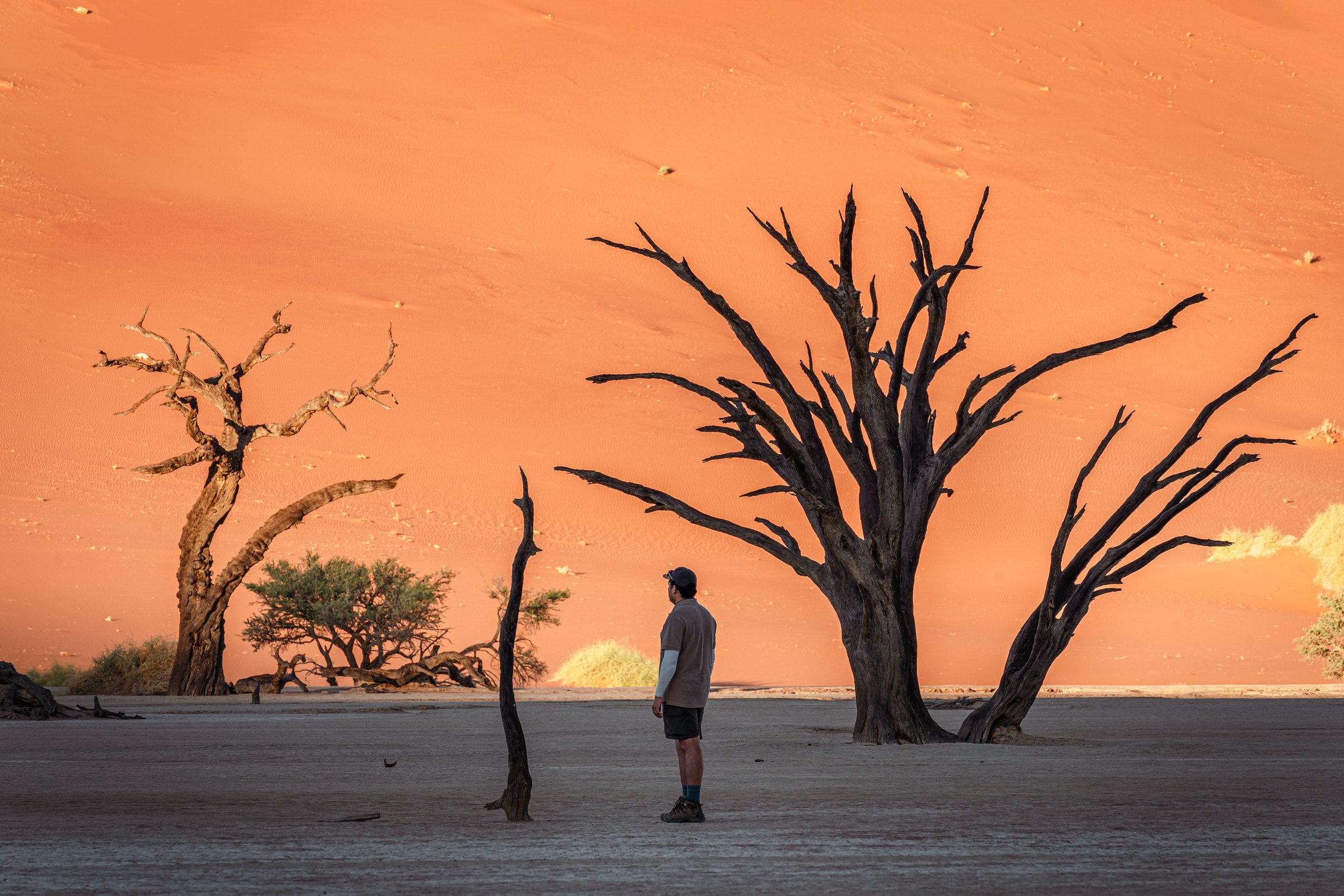When and How to Visit the Ancient Trees of Dead Vlei in Sossusvlei in Namibia
The ancient trees of Dead Vlei, located in the heart of Sossusvlei, stand as haunting silhouettes against the backdrop of towering red dunes. These dried, blackened acacia trees, some believed to be over 900 years old, contrast the white clay pan and the vibrant orange sand. Once nourished by a river that has long since dried up, the trees now serve as a testament to the harsh environmental conditions of the Namib Desert. Their eerie yet captivating presence draws photographers and nature lovers alike, making Dead Vlei a must-visit destination for those seeking to witness the stark beauty of this unique landscape.
Just a quick hello, I am Muji, and I am so glad you stopped by! I am a passionate photographer and filmmaker living in beautiful Cape Town, South Africa. I love sharing my skills and offer personalized photography sessions or fun workshops for small groups. If you’re excited about embarking on a Namibian adventure, don’t hesitate to reach out! I can’t wait to connect with you!
Let’s discuss visiting this stunning location both as a tourist and as a photographer, with two photo galleries below for your reference as well.
The ancient trees of Dead Vlei during a quiet month of February
How do you reach Dead Vlei to see the ancient trees?
Except for the last few kilometers, the drive to Dead Vlei is on a well-maintained tar road and offers stunning scenic views within Sossusvlei National Park. Don’t rush past the opportunity to stop at various dunes and explore the surrounding landscape, including hiking some dunes and walking among other ancient trees outside Dead Vlei (the main tourist attraction). So remember, Dead Vlei is where the ancient trees are, Sossusvlei National Park is where you need to go to reach Dead Vlei.
To reach Dead Vlei in Sossusvlei, hiring a high-clearance 4x4 vehicle is best if you’re not joining a guided tour, as the terrain can be quite sandy and muddy towards the end. Plan to start your journey in the early morning hours to escape the heat, and remember that the national park has specific opening hours—you’ll need to exit the entrance gate by a designated time depending on the season. To enhance your experience, especially if you are there for photography, consider securing accommodation or a camping site within the park, allowing you to be among the first to drive to the ancient trees, as the main gate for non-resident visitors opens later in the morning. The park has an entrance fee, and you can enjoy preferential rates for the SADC region residents.
Can you go alone?
Yes, you can go alone. But bringing a companion is also a good idea to make your trip even more memorable. It’s a safe place. After parking your vehicle, be prepared for a short walk through the soft, inviting sand before you arrive at the mesmerizing Dead Vlei.
When should you visit the ancient trees of Dead Vlei as a tourist?
The best time to visit the ancient trees of Dead Vlei in Namibia is during the cooler months from May to September, when temperatures are more manageable and the landscape is particularly striking. Early morning or late afternoon offers the most favorable lighting for photography, casting long shadows and highlighting the dramatic contrasts between the blackened acacia trees, the white clay pan, and the vibrant red dunes. Additionally, visiting during these months allows you to experience the beauty of the Namib Desert without the intense heat of midday. It's advisable to arrive early to enjoy the serene atmosphere and capture the stunning dawn light as it bathes the area in a warm glow, making for an unforgettable experience amidst this unique and haunting landscape.
Check out the photo gallery below. It shows that we stayed and camped inside the park, which is affordable. We brought our mini fridge and cooked our meals to keep costs down. On the first night, we had to cook inside our toilet/shower during a sand storm. You will also notice the walk to the ancient trees of Dead Vlei; it’s quite a trek, and you arrive in a large valley of trees both vast and surrounded by dunes.
When should I visit the ancient trees of Dead Vlei as a photographer?
As a photographer, visiting the ancient trees of Dead Vlei during the hot months of February and March offers a unique experience marked by dramatic weather patterns. This time of year often brings thunderstorms and quickly forming rain clouds that can create stunning compositions against the stark landscape. The park tends to be quieter during these months, allowing for fewer tourist distractions and an opportunity to capture the solitude and beauty of the area. However, while the sight of towering thunderheads and electric skies can be exhilarating, caution is essential. I learned this the hard way when we were caught in a sudden storm, barely managing to escape the sand storm and the lightning all around us. Despite the risks, the captivating visuals and atmospheric conditions achievable during this period make it a photographer's dream. The mission encompasses capturing the unique features of Dead Vlei and exploring the various attractions that Sossusvlei National Park has to offer along the way. During our journey, we photographed the stunning dunes at different times of the day, which provided a remarkable experience. The photos below showcase the beauty of the landscape and are a source of pride for us. I recommend planning for a minimum of three nights in the area. This will give you ample time to explore and find locations that resonate with you. Consider taking night photos by strategically setting your camera on a timer and pre-composing your shots; this can yield captivating results.
Additionally, try to shoot in different lighting conditions, including sunny scenarios and during thunderstorms, for a diverse range of images. Don’t hesitate to drive around and explore the surroundings—there's so much to see beyond just the campsite, even when it’s hot outside. It’s better to keep an eye on the weather and ask local guides when storms and floods are predicted, and then go there, as the weather patterns are slightly different every year. As I said earlier, you can always contact me if you want me to take you there, guide, and teach you. Check out some of my photos from Sossusvlei below.
While you are here, don’t forget to snag a free copy of my landscape photography eBook or some awesome Lightroom Presets! You need to share your email, which also subscribes to my Sunday Morning Beans newsletter, where I’ll send you some life motivation and handy photo tips, I only send a 5-minute read every Sunday morning with no marketing spam. Many have subscribed to it and we have a community that learns from one another. And don’t worry, you can unsubscribe whenever you like, even right after downloading! I don’t mind at all. 😊
What not to do in Dead Vlei and Sossusvlei Park
Always be respectful to nature—please refrain from climbing the trees and flying drones in the area. Many night-time photographs of the trees were captured before current restrictions were implemented; now, photographers often leave their cameras overnight to capture stunning shots and return when the entrance opens to grab their cameras before other visitors arrive quickly.
Enjoy the journey—it’s about more than just the destination!
If you are learning photography as a beginner, I also offer one-on-one online and in-person photography/filmmaking coaching. The best way to learn is also my beginner photography course, which takes students from beginner to confident master photographer.
Kind regards
Muji

























